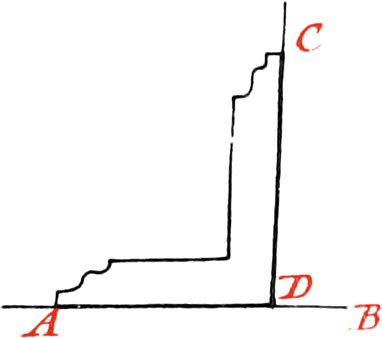It is made of two Rulers of Brass, or other Metal, joined Fig. D. in such manner as to make a right Angle with each other. There are some Squares, whole two Rulers, or Branches, are firmly fixed; and others that open and fruit by help of a Joint, that ought to be well fitted to hinder the Square from shaking; and that it may preserve it’s right Angle. To do which, there is adjusted in a small Gutter made at the Angle (which is 45 Degrees) of one of the Branches of the Square, three Knuckles proportionable in Length and Breadth, to the Length and Breadth of the Square. These Knuckles ought to be so far distant from each other, that they may exactly receive between them two other Knuckles, which are adjusted to the other Branch of the Square. The Knuckles being thus placed, are soldered to the Branches, and afterwards are united to one another by means of a Pin, which must exactly fill the Cavity of the Knuckles, that thereby the Motion of the Branches may be steady.
Note. There are some Squares to which a Thread and Plummet is hung, which serves for levelling; that is, to make horizontal Planes: also upon one of the Sides of the Square are sometimes sundry Lines and Scales placed; and upon the other, half a Foot divided into 6 Inches, every one of which is subdivided into 12 Lines: moreover, there are sometimes added to it other Country Measures compared with the Paris Foot.

